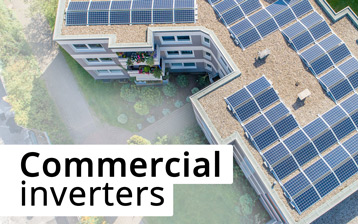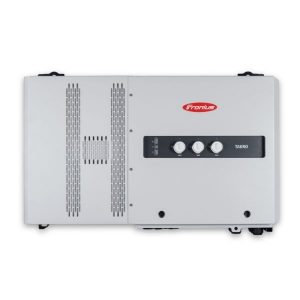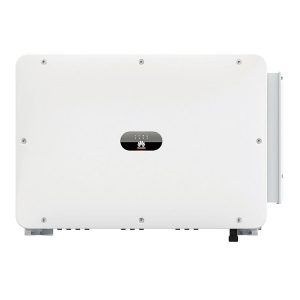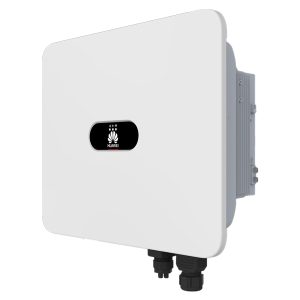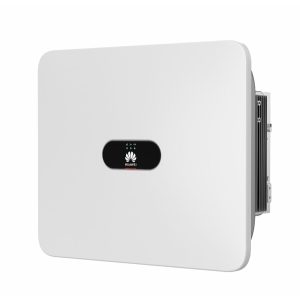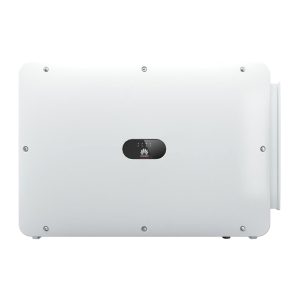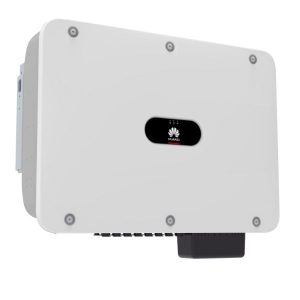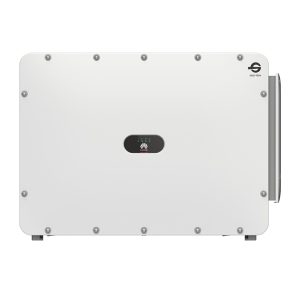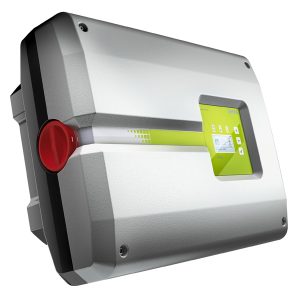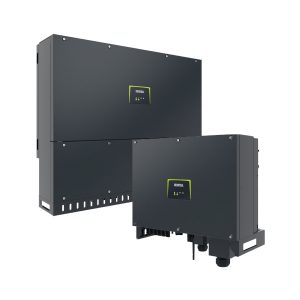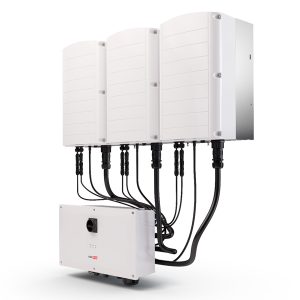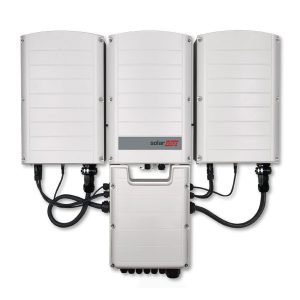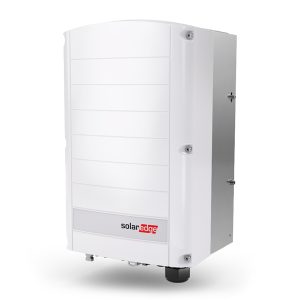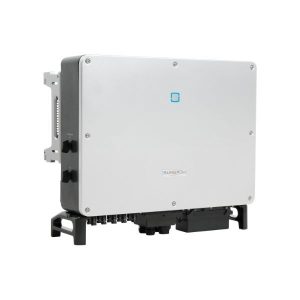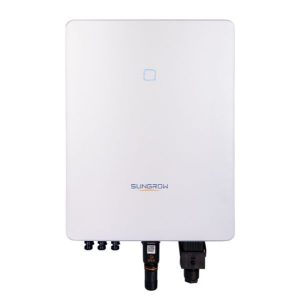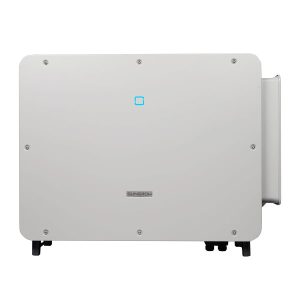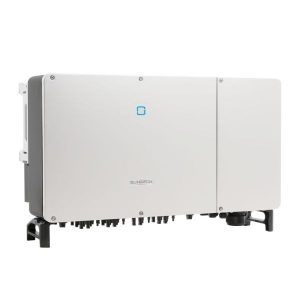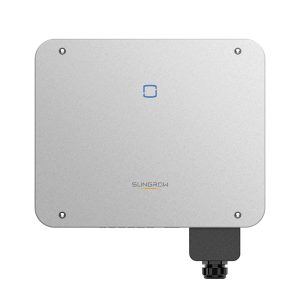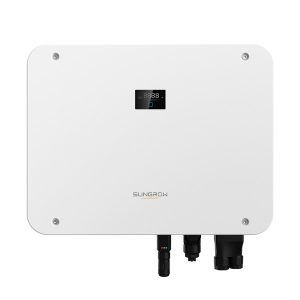The main difference between inverters for residential and commercial systems is the size. It actually determines the inverter’s employment. Usually commercial inverters are those with a power higher than 10kW.
Generally commercial inverters are certified CEI 0-21 as well as CEI 0-16, regulating the connection to low, medium and high voltage grids .
Energy conversion is not their only feature. They actually do implement technologies to make a more efficient and long-lasting system. As follows some of the involved technologies:
MPPT: Maximum Power Point Tracker
Using MPPT (Maximum Power Point Tracker) the inverter maximizes energy production by photovoltaic modules. This technology ensures that every single photovoltaic string works at its maximum power point.
Anti-PID technology
Photovoltaic modules performances are mainly affected by PID (Potential Induced Degradation). A degradation caused by voltage difference between the cells and modules’ frames.
Anti-PID technology is now implemented to all commercial inverters in order to reduce performance degradation of PV modules.
Arc Fault Circuit Interruption
Commercial inverters are usually equipped with AFCI (arc-fault circuit interrupter). A device aiming to interrupt the circuit when electric arcs are detected. An hazard to be avoided as it’s an evidence of loose connections in the wiring.
One of the most common causes of fires on roofs where PV systems are placed.
Multistring
Recent inverters manage to connect multiple strings of modules to the same MPPT. Allowing to simplify installation by avoiding junction boxes.
Technical features
Commercial inverters have a power starting from 10/20 kW. Generally it is accepted DC input up to 1000V/1100V.
MPPTs change from 2 to 10 depending on inverter power. Concerning the output it is three-phase at 400V.
These devices are usually equipped with safety systems such as:
- Reverse polarity protection
- Type I or Type II over voltage protection
- AFCI
Operation & Maintenance
In this case we refer to an ordinary and extraordinary maintenance plan necessary to guarantee full functionality and productivity.
A number of activities aiming to maintain the PV system efficient and avoiding any downtime. A fair maintenance routine plan as well as constant monitoring of the data system allow a full efficiency.
Electrical workshop
Commercial inverters are often used in electrical workshops, also known as power generation workshops.
Energy production plants from renewable sources are normally handled by the same company, with a peak power of more than 20 kW and an energy generation aimed at self-consumption.
Every plant drawing energy from renewable sources that exceeds 20 kW installed for the production of self electricity consumption, must be reported to the office of the Customs Agency of the competent territory.
Monitoring
Monitoring plays an important role in this type of inverter, as it allows to spot any problem in the system and to intervene in time to repair the breakdown.
It is clear that being able to quickly identify the problem allows the installer to save time as well as make the operation cheaper for the end customer.
Commercial inverters are often combined with data loggers in big plants. They verify inverters’ production connected to them, and at times sensors can be added to allow recording additional measurement values, such as irradiation and the ambient temperature.
-
Fronius, Inverter, Inverter for commercial and industrial PV systems, Photovoltaic inverter
Fronius Tauro – 50/100 kW – inverter for commercial and industrial systems
 Fronius, Inverter, Inverter for commercial and industrial PV systems, Photovoltaic inverter
Fronius, Inverter, Inverter for commercial and industrial PV systems, Photovoltaic inverterFronius Tauro – 50/100 kW – inverter for commercial and industrial systems
Fronius Tauro is an inverter useful for any commercial and industrial system, suitable for installation outdoors in contact with extreme climates .
- Reduces installation costs (BOS)
- Mechanical ventilation for maximum performance even under the sun’s rays
- maintenance can be done in the field by one person
SKU: n/a
-
Commercial inverter Huawei, Huawei, Inverter, Photovoltaic inverter
Huawei SUN2000 100 / 115 KTL – M2 – three-phase
 Commercial inverter Huawei, Huawei, Inverter, Photovoltaic inverter
Commercial inverter Huawei, Huawei, Inverter, Photovoltaic inverterHuawei SUN2000 100 / 115 KTL – M2 – three-phase
Huawei three-phase inverter, ideal solution for commercial and industrial installations.
- 10 MPPT, 20 inputs
- Integrated DC circuit breakers
- IP66
- RS485, MBUS, USB, optional: WiFi, Ethernet, 4G / 3G / 2G
- Available models: 100KTL-M2, 115KTL-M2
SKU: n/a -
Commercial inverter Huawei, Huawei, Huawei, Hybrid inverter, Inverter
Huawei SUN2000 12/15/17/20/25 K-MBO – three-phase hybrid inverter
 Commercial inverter Huawei, Huawei, Huawei, Hybrid inverter, Inverter
Commercial inverter Huawei, Huawei, Huawei, Hybrid inverter, InverterHuawei SUN2000 12/15/17/20/25 K-MBO – three-phase hybrid inverter
Three-phase hybrid SUN2000 12/15/17/20/25 K-MBO inverter ideal for C&I systems, with sizes ranging from 12 to 25 kW
- Efficiency up to 98.2
- Weight and footprint (546 x 460 x 228 mm, weight approx. 21kg)
- IP66 degree of protection
SKU: n/a -
Commercial inverter Huawei, Huawei, Inverter, Photovoltaic inverter
Huawei SUN2000 12/15/17/20/25 KTL-M5 – three-phase
 Commercial inverter Huawei, Huawei, Inverter, Photovoltaic inverter
Commercial inverter Huawei, Huawei, Inverter, Photovoltaic inverterHuawei SUN2000 12/15/17/20/25 KTL-M5 – three-phase
The Huawei SUN2000 M5 three-phase string inverter was created to maximize energy yields in residential and commercial PV systems.
- 2 MPPT (two inputs each)
- RS485, Optional: Ethernet, WiFi, 4G
- IP66 protection rating
- Available sizes: 12/15/17/20/25 KTL-M5
SKU: n/a -
Commercial inverter Huawei, Huawei, Inverter, Photovoltaic inverter
Huawei SUN2000 215 KTL – H0 & H3 – three-phase inverter
 Commercial inverter Huawei, Huawei, Inverter, Photovoltaic inverter
Commercial inverter Huawei, Huawei, Inverter, Photovoltaic inverterHuawei SUN2000 215 KTL – H0 & H3 – three-phase inverter
Three-phase string inverter for utility scale applications.
- Number of MPPTs: 9 (H0) or 3 (H3)
- Maximum input voltage: 1500 V
- AC output voltage: 800 V 3P + PE
- Integrated DC circuit breakers
- IP 66
- RS485, MBUS, USB, optional: WiFi, Ethernet, 4G / 3G / 2G (with SmartLogger 3000A)
- Available models: 215KTL-H0 / 215KTL-H3
SKU: n/a -
Commercial inverter Huawei, Huawei, Inverter, Photovoltaic inverter
Huawei SUN2000 30/36/40/50 KTL-M3
 Commercial inverter Huawei, Huawei, Inverter, Photovoltaic inverter
Commercial inverter Huawei, Huawei, Inverter, Photovoltaic inverterHuawei SUN2000 30/36/40/50 KTL-M3
Commercial Huawei inverter with three-phase output, ideal solution for new installations.
- 4 MPPT, 8 inputs
- Maximum input voltage: 1,100V
- Integrated DC circuit breaker
- Available models: 30 KTL-M3, 36 KTL-M3, 40 KTL-M3, 50 KTL-M3
SKU: n/a -
Commercial inverter Huawei, Huawei, Inverter, Photovoltaic inverter
Huawei SUN2000 330 KTL – H1 – three-phase inverter
 Commercial inverter Huawei, Huawei, Inverter, Photovoltaic inverter
Commercial inverter Huawei, Huawei, Inverter, Photovoltaic inverterHuawei SUN2000 330 KTL – H1 – three-phase inverter
With this three-phase string inverter, Huawei wanted to create the perfect product for large photovoltaic systems.
- 6 MPPTs
- Number of inputs per MPPT: 4/5/5/4/5/5
- AC output voltage: 800 V 3P + PE
- Integrated DC circuit breakers
- IP66
- RS485, MBUS, USB
SKU: n/a
-
Commercial inverter Kostal, Inverter, Kostal, Photovoltaic inverter
Kostal Piko 15 – 20 kW
Kostal Piko inverter are very reliable, ideal for the most complex applications.
The Piko string inverters offer unparalleled functionality virtually all types of PV systems.
- 3-phase feed-in
- Up to 3 MPP trackers
- Available sizes: 15 – 20 kW
SKU: n/a -
Commercial inverter Kostal, Inverter, Kostal, Photovoltaic inverter
Kostal PIKO CI 30/50/60
PIKO CI (Commercial Inverters) series optimized for the needs of large photovoltaic systems.
Greater safety and efficiency, lower additional costs thanks to the integrated Kostal Smart AC Switch which makes external pling switches redundant.- system voltage of up to 1100 V
- DC installation without any string distribution boxes
- Over-assignment of up to 50% (DC to AC) permits flexible generator design
- Available sizes: 50 kW
SKU: n/a
-
Inverter, Inverter for commercial and industrial PV systems, Photovoltaic inverter, SolarEdge
SolarEdge commercial three phase Synergy inverter SE50K – SE120K
 Inverter, Inverter for commercial and industrial PV systems, Photovoltaic inverter, SolarEdge
Inverter, Inverter for commercial and industrial PV systems, Photovoltaic inverter, SolarEdgeSolarEdge commercial three phase Synergy inverter SE50K – SE120K
Three-phase inverter for commercial systems with Synergy technology. Composed of multiple separate units that are easy to connect and install thanks to their small weight and size.
- Independent operation of each unit allows for greater uptime and ease of maintenance
- Integrated module-level monitoring
- Automatically reduces DC voltage to touch-safe levels during system shutdown with integrated SafeDC™
- More energy production with up to 150% DC oversizing
- Long-term 12-year warranty, extendable to 20 years
- Available sizes: SE66.6K – SE90K – SE100K
SKU: n/a -
Inverter, Inverter for commercial and industrial PV systems, Photovoltaic inverter, SolarEdge
SolarEdge SE40K
 Inverter, Inverter for commercial and industrial PV systems, Photovoltaic inverter, SolarEdge
Inverter, Inverter for commercial and industrial PV systems, Photovoltaic inverter, SolarEdgeSolarEdge SE40K
SolarEdge inverters have an efficient conversion architecture so as to have maximum reliability and performance in terms of energy produced.
Standard warranty of 12 years.
Local and remote monitoring of integrated and function module level.
SKU: n/a -
Inverter, Inverter for commercial and industrial PV systems, Photovoltaic inverter, SolarEdge
SolarEdge Three Phase Inverters SE66.6K-SE100K
 Inverter, Inverter for commercial and industrial PV systems, Photovoltaic inverter, SolarEdge
Inverter, Inverter for commercial and industrial PV systems, Photovoltaic inverter, SolarEdgeSolarEdge Three Phase Inverters SE66.6K-SE100K
Three-phase inverter for medium voltage connections with new synergy technology. Designed to work with power optimizers and integrated module-level monitoring.
- Composed of multiple units that can be connected to each other
- Lightness and simplicity of installation
- Integrated Connection Unit with optional integrated DC Safety Switch
SKU: n/a -
Inverter, Inverter for commercial and industrial PV systems, Photovoltaic inverter, SolarEdge
SolarEdge: three phase SE20K – SE33.3K
 Inverter, Inverter for commercial and industrial PV systems, Photovoltaic inverter, SolarEdge
Inverter, Inverter for commercial and industrial PV systems, Photovoltaic inverter, SolarEdgeSolarEdge: three phase SE20K – SE33.3K
SolarEdge three-phase inverters have an efficient conversion architecture for maximum reliability and performance in terms of energy produced.
- designed to work with power optimizers
- Superior efficiency (98.3%)
- Integrated module-level monitoring
- 12-20 year warranty
- Available sizes: SE20K – SE25K – SE30K – SE33.3K
SKU: n/a
-
Commercial inverter Sungrow, Inverter, Photovoltaic inverter, Sungrow
Sungrow SG 33/40/50 CX
The three-phase string inverters SG 33-40-50 CX are the most suitable choice for companies that will be able to make the most of their photovoltaic system thanks to a maximum efficiency that reaches 98.7%.
- 3\4\5 MPPT
- IP66 (suitable for outdoors)
- Wi-Fi, Ethernet
- 5-year guarantee
- Available models: SG33CX_V112 / SG40CX_V112 / SG50CX_V112
SKU: n/a -
Commercial inverter Sungrow, Inverter, Photovoltaic inverter, Residential inverter Sungrow, Sungrow
Sungrow SG 5.0/6.0/7.0/8.0/10/12/15/17/20 RT
 Commercial inverter Sungrow, Inverter, Photovoltaic inverter, Residential inverter Sungrow, Sungrow
Commercial inverter Sungrow, Inverter, Photovoltaic inverter, Residential inverter Sungrow, SungrowSungrow SG 5.0/6.0/7.0/8.0/10/12/15/17/20 RT
This range of three-phase string inverters produced by Sungrow is ideal for small and medium-sized residential and commercial systems. These inverters are able to offer high efficiency, without sacrificing smart management, making everything safe and easy to use.
- 2 MPPT
- IP65
- Plug and play connector on the AC side and MC4 on the DC side
- Wlan, Ethernet
- Available sizes: SG5.0RT, SG6.0RT, SG8.0RT, SG10RT, SG12RT, SG15RT, SG17RT, SG20RT.
SKU: n/a -
Commercial inverter Sungrow, Inverter, Photovoltaic inverter, Sungrow
Sungrow SG125CX-P2
SG125CX-P2 is a Multi-MPPT string inverter for 1000 VDC systems, optimizes its solutions for the C&I range with 12 MPPT ensures greater flexibility in system design.
- Up to 12 MPPT
- efficiency 98.5%
- IP66 protection and class C5 anti-corrosion grade
- Dynamic shading optimization mode
- Equipped with AFCI 2.0
- DC input of 30 A per MPPT
- Evo2 DC connection – AC connection OT/DT terminal
SKU: n/a -
-
Commercial inverter Sungrow, Inverter, Photovoltaic inverter, Sungrow
Sungrow SG33/50CX-P2
The SG 33/50 CX-P2 three-phase string inverters combine power and safety with a weight reduction of 34% compared to the previous series.
- 3\4 MPPT with 2 inputs each
- Maximum MPPT current: 30 A
- IP66 protection and C5 corrosion resistance
- Integrated DC circuit breaker
- RS485, Optional: Wi-Fi, Ethernet
- Available sizes: SG50CX-P2
SKU: n/a -
Commercial inverter Sungrow, Inverter, Photovoltaic inverter, Sungrow
Sungrow SH 15 / 20 /25 T – three-phase hybrid inverter
 Commercial inverter Sungrow, Inverter, Photovoltaic inverter, Sungrow
Commercial inverter Sungrow, Inverter, Photovoltaic inverter, SungrowSungrow SH 15 / 20 /25 T – three-phase hybrid inverter
The SH-T three-phase hybrid inverter is the most powerful solution among Sungrow’s hybrid inverters and is an excellent solution for commercial and industrial systems that require storage.
- 3 MPPT, 5 DC inputs
- Compatible with Sungrow and BYD high voltage batteries
- IP65
- 10-year warranty
- Communication: RS485, WLAN, Ethernet, CAN
- Available sizes: SH15-T / SH20-T / SH25-T
SKU: n/a





